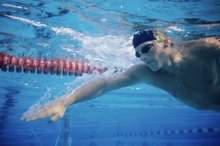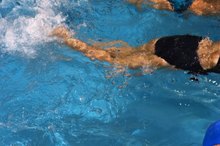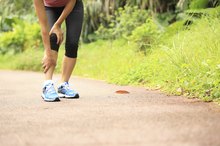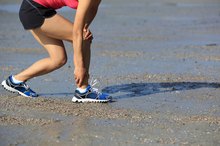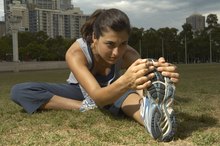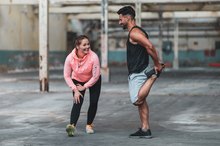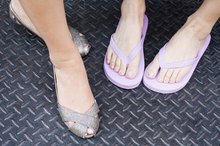Swimming & Pain in the Calf Muscles
Pain in the calf muscles can occur while swimming. This primarily happens when the toes are kept pointed -- called the plantar flexion action -- throughout the activity. This positioning causes contraction of all the muscles of the lower legs, including the calf muscle, the toes and the arch, and it flattens the front part of the foot. Although plantar flexion action initially propels you forward at a faster pace, it increases stress on the foot and calf muscles because the muscles remain contracted for longer.
Fins and Cramps
According to Haydn Wooley in the August 2001 edition of "Extreme Tri Magazine," plantar flexion action is the primary reason for cramps during swimming. When sustained, this action causes tightness in the calf muscles that become cramps if the tension is not relieved. Some swimmers use fins to kick more powerfully in an attempt to avoid the plantar flexion. Unfortunately, fins also can cause cramping because they place more pressure on the feet during the kicking phase. This causes unnecessary calf muscle contractions during swimming, which can lead to cramps.
- According to Haydn Wooley in the August 2001 edition of "Extreme Tri Magazine," plantar flexion action is the primary reason for cramps during swimming.
- Unfortunately, fins also can cause cramping because they place more pressure on the feet during the kicking phase.
The Shallow End
Ankle Pain & Swimming
Learn More
Electrolyte imbalance in the body can cause muscle cramps. Limited blood supply also can cause leg cramps. For instance, when the body is exposed to extreme cold water, it can constrict the blood vessels that supply leg muscles. This can lead to cramping and muscle fatigue. Hard exercises before swimming also can cause muscle fatigue and pain. Overuse of the calf muscles causes muscle strain. Low levels of calcium and potassium in the blood can also cause cramps and muscle pain.
- Electrolyte imbalance in the body can cause muscle cramps.
- Low levels of calcium and potassium in the blood can also cause cramps and muscle pain.
Calf Conditioning
You can follow a conditioning program to improve calf muscle strength in order to avoid calf strain during swimming. When you are swimming, let the ankles flick around in the water and make easy relaxed movements; your ankles should be totally relaxed while swimming. Relax and do a little warm up before swimming; float on your back with your ankles relaxed, looking at the ceiling or sky, and slowly kicking with feet or flippers. Introduce fins, even short fins, back into your workout slowly, over a period of time.
- You can follow a conditioning program to improve calf muscle strength in order to avoid calf strain during swimming.
- When you are swimming, let the ankles flick around in the water and make easy relaxed movements; your ankles should be totally relaxed while swimming.
Easy Does It
What Causes Leg Cramps While Swimming?
Learn More
Unless you are a well-conditioned swimmer, you should not attempt hard kicks. Slowly ease into longer or harder workouts; increase duration or intensity by only 10 percent a week. If you experience calf pain or any other pain, discontinue swimming and see a doctor or physiotherapist. Speak to a professional swim coach to ensure you are using proper foot and ankle positioning during your swims.
- Unless you are a well-conditioned swimmer, you should not attempt hard kicks.
- Speak to a professional swim coach to ensure you are using proper foot and ankle positioning during your swims.
Related Articles
References
- Extreme Tri Magazine: Cramping Your Style "Dealing With Cramps In The Pool"
- Sports Injury Clinic: Calf Strain
- Sports Injury Clinic: Cramp Calf Muscles
- Johnson RE, Haas K, Lindow K, Shields R. Plantar fasciitis: What is the diagnosis and treatment?. Orthop Nurs. 2014;33(4):198-204: quiz 205-6. doi:10.1097/NOR.0000000000000063
Writer Bio
Rick Rockwell is a self-employed personal trainer and experienced freelance writer. His articles have been published throughout the Internet. He has more than eight years of experience as a certified personal trainer, group fitness instructor and lifestyle coach. His company, Rockwell Fitness, is dedicated to educating and empowering others to live healthy lifestyles.
